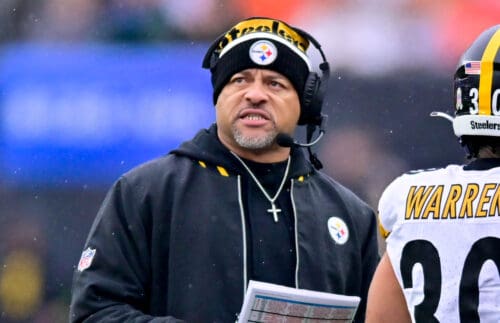Steelers Analysis Steelers News
2 Key Changes Steelers New OC Eddie Faulkner Made to Offense

PITTSBURGH — The Steelers have two new sheriffs in town after firing Matt Canada last week. With Eddie Faulkner working as the offensive coordinator and Mike Sullivan as the play caller, it’s an interesting workflow that maximizes detail and importance throughout the staff. While the changes on the field were evident, the off-the-field changes might have worked their way onto the field more than anything. Last week, Faulkner noted that he was a detail-first guy. That has the locker room buying into what Faulkner is selling, and they seem bought in.
“Just me in general, I’m a detailed guy,” Faulkner said. “That’s how I operate. That’s how I operated the running back room, so that’s how I’m operating anything that has to do with the offense or staff. To make sure we’re squeezing down, tightening up, closing all the space so when we go into a game the guys can execute and play fast. That’s the focus, and I feel like I can bring somebody to the table in that regard.”
So, that detail is a change, but implementing that approach is a little harder. Faulkner did two things to change that around, and players seem to love it, and they’re not wondering about things anymore. The ‘why’ of the offense does not have to be answered.
“The buy-in felt great,” Faulkner said. “I love the energy. I don’t think they can fake it that good, for it not to feel real, and it feels real. And so man, we just going to take that momentum and keep rolling with it.”

In-Depth Meetings with Each Position Room
Faulker engineered a week where the meetings changed. The running backs and offensive linemen changed their meeting times on their own after the bye week. But Faulkner implemented something similar to the passing game with the quarterbacks and all of the eligibles in there. The receivers, Kenny Pickett, Faulkner, and Sullivan sat down, went through each area of the field an each potential situation, and picked out the plays they liked the most. Does it sound bare minimum? Yes, but when the communication was that off, guys were left wondering ‘why’ some things happened. Calvin Austin III saw the difference.
“I’d say it was intentional,” Austin said. “Coach Sully and Coach Faulk were spelling out every situation we’ll be in and what we can expect from him to call. It was really them laying out, ‘in this situation, we’ll do this’, and ‘you can expect this’, so we came into the game knowing ‘oh, we’re in this 3rd-and-5 and we know what play is going to get called. It was everybody being understanding and knowing the goal of play call, and in each situation, knowing what to expect.”

More than anything, Faulkner involved all the assistants in explaining in greater detail why everything happened. These concepts and ideas seemed to put everyone on the same page. Interestingly, most of the communication errors were gone. They overcommunicated and talked about each of the play calls they would like and why they were going to call them.
“They went through with the entire offense and told them in detail why everything was going to happen,” Austin said. “I feel like, in general, it’s not just from play calling, but it was all of the guys on the offense knowing what to expect, being on the same page, and we weren’t going out there wondering like,’ why are we doing this’? And not to say we weren’t in the past, but it just removing any chance of there being questions.”
Hammer Details
It goes just beyond that, though. Sullivan and Faulkner went into great detail about what to expect from the plays. Not only did they explain the why of a play call or tell the guys which call to expect, but they went into specific route depths versus certain leverages, how to play against these coverages, what shoulder the ball should be thrown on, and hammering home the very specific details of each play.

In other words, there was no wondering about the play. The receivers knew how to stem their routes. They knew how to play against certain leverages and calls they would see from the Bengals. All of that got hammered out before they even stepped on a field.
“All of those details we’re definitely something they pushed,” Austin said. “They were all about eliminating any uncertainty in a play. That’s what they said in each meeting. Each thing was spelled out and everyone knew their assignment to an exact detail; So, it’s not like guys just came out and were like,’oh, I was thinking this,’ it was like, no, we already spelled out how it should be before we take the field. Everybody was behind that train and that’s why we flowed.”
Faulker punctuated all the details. He showed guys that on Sunday, they can get things going, but not everything is there yet. But at the very least, the morale is high and people believe in his message. That was always the first step for Faulkner and Sullivan after the team moved on from Canada, and it seems that is just what happened.
“We scheduled meetings and did some things a little bit different so we had total clarity on things,” Faulkner said. “That’s really it. It was not much different than that. We really honed in on the details. I’ve got to say man, the offensive staff was incredible.”
Those details need to be sharp. The communication between everyone must be sharp. If those baseline things can at least improve, Pittsburgh’s offense, which was one of the worst units in football, can improve to one that has an average all-around showing week in and week out. The good for the Steelers is that you can improve these things over the season, and certainly, the communication got cleaned up quickly. So, it seems things are moving in the right direction.
